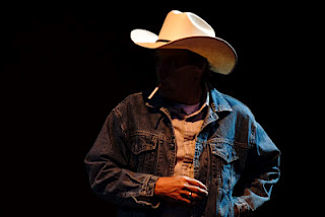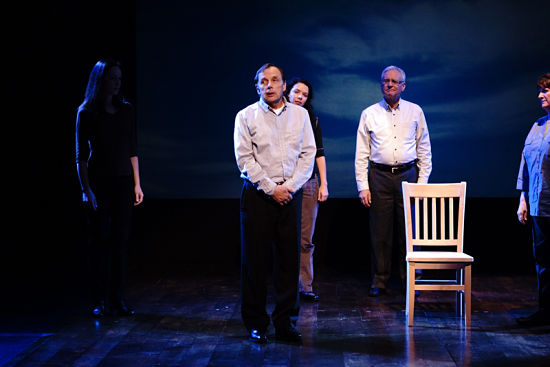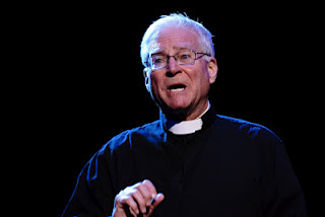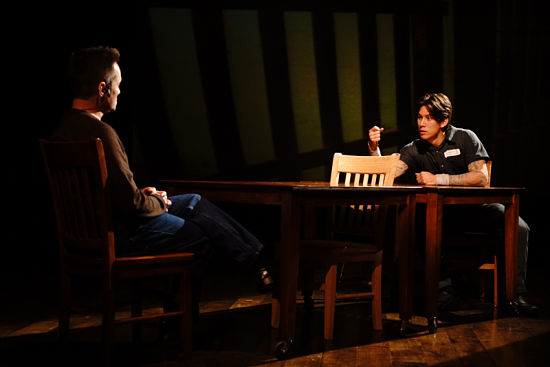Review: The Laramie Project Ten Years Later by Zach Theatre
by Michael Meigs
You know these people; you're comfortable with them. Most likely because you attended their portrayal in March and April of The Laramie Project, but possibly also because you recognize them as the Zach regulars who have appeared before you so many times. The Laramie Project 10 Years Later has the reassuring buzz of a class reunion, which is something like the way it must have been for the Tectonic Theatre Project as they undertook the visits and research in 2008 that led to this text.
The Laramie Project featured the looming absence of gentle Matthew Shepard, the boy-man who was enticed by two men from a bar into a pickup and then driven out to be beaten almost to death, left tied to a fence in a remote and desolate location. It was crafted to tell the horrific, inexorable story of that spectacular event, the investigation and the actions in response both of the justice system and the townspeople of Laramie, a town of fewer than 30,000 persons on I-80 just north of the Colorado border. The work had a necessary beginning in outrage, a middle of reflection and discussion and an end featuring retribution and mercy.

10 Years Later has no such clean plot line, although Moisés Kaufman and the credited collaborators of the Tectonic Theatre Project worked assiduously to give it one.
They discovered that the vivid accounts at the trial and in the newspapers were no longer a daily reality in Laramie but instead the story of Matthew Shepard had undergone transformation, partly due to the collective process of healing via forgetfulness and partly due to disinformation from a national investigative television program that claimed drug use and drug dealing lay behind the murder. The theatre troupe's interviews and re-enactments battle those claims, trying to re-establish for their wider audience the picture of a despicable hate crime. They also chart the successful emergence from the closet of a woman who won a seat in the legislature and the ideological combat there over a proposed amendment to the Wyoming constitution to define marriage as consisting solely of the union between a man and a woman.

The continuation of the story does not achieve the impact of the original, a shortfall certainly familiar in the world of big budget cinema. Here, however, the play is less effective because in face of the forgetting, the writer/investigator/players are necessarily presented as driven by a thesis. It's a thesis with which I agree as patently do those who attend this production: all human beings, regardless of gender identification or preference, should be entitled to their dignity, civil treatment, freedom of choice and equality before the law.
 This is preaching to the choir, for those most in need of the message will never hear it. Or else they will hear it by mistake, as was reportedly the case of a couple of people in Zach's audience for The Laramie Project who were scandalized because they "had no idea that it was a play about homosexuals."
This is preaching to the choir, for those most in need of the message will never hear it. Or else they will hear it by mistake, as was reportedly the case of a couple of people in Zach's audience for The Laramie Project who were scandalized because they "had no idea that it was a play about homosexuals."
Most effective in 10 Years Later is the look deep into the eyes of those who carried out the murder. Harvey Guion as Catholic priest Father Roger Schmit urges the investigators to call on them in Federal prison; Schmit's Christ-like attitude toward such monsters seems initially in this context almost incomprehensible.

But as Martin Burke and Frederic Winkler enact those visits in turn -- one as the prisoner, the other as the researcher from Tectonic Theatre -- we witness two profoundly contrasting moral views. Burke as convicted murderer Russell Henderson is contrite, resigned and self-accusing, the picture of remorse when interviewed by Winkller as company member Andy Parris.
Minutes later, Burke as company member Greg Pierotti leans across a table in the visiting rooms and shakes the hand of Winkler as convicted murderer Aaron McKinney. Their interview is a disquieting look into McKinney's unapologetic acknowledgement of events, his confirmation that he belongs in jail and the strong suggestion that he would murder a homosexual again if he had the opportunity. This is the cold regard of deep-held loathing, including self-loathing; it is the disheartening spectacle of the banality of evil.

Director Dave Steakley provides strong pictures in this production, often relying on the striking lighting design of Jason Amato. Visual echoes of Wilder's Our Town in Steakley's 2010 staging of it right here are frequent.
You won't have to search for a candle under your seat at the conclusion. Company members climb the aisles into the audience, each choosing someone to invite to take place with him or her on the quilt spread out on stage, a ghost of the HIV-AIDS memorial quilt laid out several times between 1987 and 1996 on the National Mall in Washington DC.
The ending of 10 Years Later is inconclusive, as it must be, for these issues remain unsettled and to some extent in strong dispute. There may eventually be room for a third iteration, a follow-up of the murder in Laramie and its consequences, but it is by no means certain that events or views will have progressed significantly in time for the original Tectonic band to mirror them to us, years hence.
Comments by Claire Canavan in the Statesman's Austin360.com Seeing Things blog, April 25 (348 words)
KXAN feature by Jim Swift with interview of Jaston Williams (video and written text), May 3
Review by Thomas Jenkins in the San Antonio Current, May 5
Review by Dan Solomon in the Austin Chronicle, May 10
Review by Ryan E. Johnson on May 13, closing date of the production
EXTRA
Hits as of 2015 03 01: 2252
The Laramie Project Ten Years Later
by Moisés Kaufmann and the Techtonic Theatre Project
Zach Theatre
